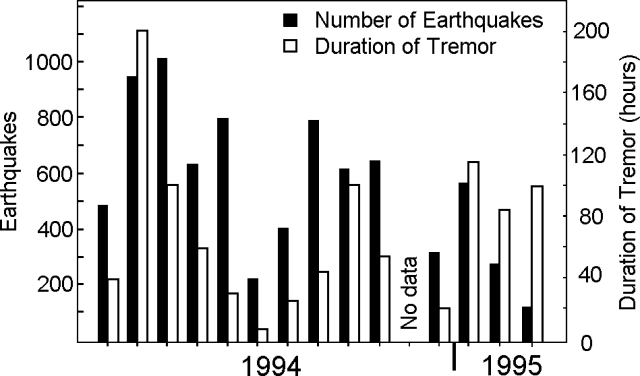Report on Arenal (Costa Rica) — March 1995
Bulletin of the Global Volcanism Network, vol. 20, no. 3 (March 1995)
Managing Editor: Richard Wunderman.
Arenal (Costa Rica) Eruptions and lava flows continue; ash deposition rate quantified
Please cite this report as:
Global Volcanism Program, 1995. Report on Arenal (Costa Rica) (Wunderman, R., ed.). Bulletin of the Global Volcanism Network, 20:3. Smithsonian Institution. https://doi.org/10.5479/si.GVP.BGVN199503-345033
Arenal
Costa Rica
10.463°N, 84.703°W; summit elev. 1670 m
All times are local (unless otherwise noted)
Crater C continued its ongoing emission of gases, lava flows, and sporadic Strombolian eruptions. The Strombolian eruptions remained similar to those of January, with ash columns reaching up to 1 km above the crater. These eruptions vibrated windows in the village of La Palma 4 km from the volcano. Falling bombs and blocks reached 1,000 m elev, ~660 m below the summit. Crater D continued fumarolic activity. Moderate low-frequency (<3 Hz) seismicity continued to decrease during March, but tremor duration remained high (figure 71).
 |
Figure 71. Arenal low-frequency seismicity for 1994 and January-March 1995. Data courtesy of OVSICORI. |
The record of ash deposition 1.8 km W of the vent (table 9) shows, in terms of total mass, that the deposition rate has increased since October 1994. Daily deposition after 3 March was 22.7 g/m2, compared to a daily average of only 7.6-8.2 g/m2 between 19 October 1994 and 3 March 1995.
Table 9. Ash collected 1.8 km W of Arenal's active vent. Courtesy of G. Soto, ICE.
| Collection Interval | Avg daily ashfall (grams/m2) | Ash % 300+µ | Ash % less than 300µ |
| 19 Oct 94-23 Jan 1995 | 7.6 | 38.0 | 62.0 |
| 23 Jan 95-03 Mar 1995 | 8.2 | 54.7 | 45.3 |
| 03 Mar 95-30 Mar 1995 | 22.7 | 42.2 | 57.8 |
Geological Summary. Conical Volcán Arenal is the youngest stratovolcano in Costa Rica and one of its most active. The 1670-m-high andesitic volcano towers above the eastern shores of Lake Arenal, which has been enlarged by a hydroelectric project. Arenal lies along a volcanic chain that has migrated to the NW from the late-Pleistocene Los Perdidos lava domes through the Pleistocene-to-Holocene Chato volcano, which contains a 500-m-wide, lake-filled summit crater. The earliest known eruptions of Arenal took place about 7000 years ago, and it was active concurrently with Cerro Chato until the activity of Chato ended about 3500 years ago. Growth of Arenal has been characterized by periodic major explosive eruptions at several-hundred-year intervals and periods of lava effusion that armor the cone. An eruptive period that began with a major explosive eruption in 1968 ended in December 2010; continuous explosive activity accompanied by slow lava effusion and the occasional emission of pyroclastic flows characterized the eruption from vents at the summit and on the upper western flank.
Information Contacts: E. Fernández, V. Barboza, and J. Barquero, OVSICORI; G. Soto, ICE.

